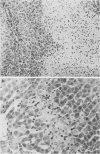Abstract
The hepatotrophic effect of portal blood was studied in rats with portal branch ligation (PBL) simultaneously subjected to mesocaval shunt or total hepatic arterialization. A direct supply of the nonligated liver lobes with pancreatic effluent did not improve DNA synthesis or mitotic response compared to arterialized rats, in which the portal-borne hepatotrophic factors reached the same lobes after systemic recirculation. A comparison with shunted but Sham-PBL rats showed that restorative capacity of the liver was not seriously impaired. In rats with PBL alone the lobes with portal occlusion showed extensive necrosis. In contrast, in PBL + shunt rats necrosis was significantly inhibited, indicating a hepatoprotective role of portal blood during hepatic arterial recirculation. Thus, the study suggests that quality of hepatic blood supply is of vital importance in maintenance of hepatocellular integrity. Hemodynamical factors seem to be of importance, but more in a sense of increased or decreased accessibility of humoral hepatotrophic factors in the blood.
Full text
PDF









Images in this article
Selected References
These references are in PubMed. This may not be the complete list of references from this article.
- Chandler J. G., Lee S., Krubel R., Rosen H., Nakaji N. T., Orloff M. J. The inter-liver competition and portal blood in regeneration of auxiliary liver transplants. Surg Forum. 1971;22:341–343. [PubMed] [Google Scholar]
- Chauvaud S., Grange D., Franco D., Bismuth H. Does hepatic blood flow decrease after portal-systemic shunt? A study in the rat. Eur Surg Res. 1973;5(6):458–464. doi: 10.1159/000127685. [DOI] [PubMed] [Google Scholar]
- FISHER B., RUSS C., UPDEGRAFF H., FISHER E. R. Effect of increased hepatic blood flow upon liver regeneration. AMA Arch Surg. 1954 Aug;69(2):263–272. doi: 10.1001/archsurg.1954.01270020129015. [DOI] [PubMed] [Google Scholar]
- Greisler H. P., Voorhees A. B., Jr, Price J. B., Jr The nonportal origin of the factors initiating hepatic regeneration. Surgery. 1979 Aug;86(2):210–217. [PubMed] [Google Scholar]
- Hess F., Willemen A., Jerusalem C. Survival of auxiliary rat liver grafts with decreased portal blood flow. Eur Surg Res. 1978;10(6):444–455. doi: 10.1159/000128036. [DOI] [PubMed] [Google Scholar]
- Lee S., Broelsch C. E., Chandler J. G., Charters A. C., 3rd, Orloff M. J. Liver regeneration following portacaval transposition in rats. Surg Forum. 1974;25(0):391–394. [PubMed] [Google Scholar]
- SCOTT J. F., FRACCASTORO A. P., TAFT E. B. Studies in histochemistry. I. Determination of nucleic acids in microgram amounts of tissue. J Histochem Cytochem. 1956 Jan;4(1):1–10. doi: 10.1177/4.1.1. [DOI] [PubMed] [Google Scholar]
- Short J., Brown R. F., Husakova A., Gilbertson J. R., Zemel R., Lieberman I. Induction of deoxyribonucleic acid synthesis in the liver of the intact animal. J Biol Chem. 1972 Mar 25;247(6):1757–1766. [PubMed] [Google Scholar]
- Starzl T. E., Francavilla A., Halgrimson C. G., Francavilla F. R., Porter K. A., Brown T. H., Putnam C. W. The origin, hormonal nature, and action of hepatotrophic substances in portal venous blood. Surg Gynecol Obstet. 1973 Aug;137(2):179–199. [PMC free article] [PubMed] [Google Scholar]
- Weinbren K., Stirling G. A., Washington S. L. The development of a proliferative response in liver parenchyma deprived of portal blood flow. Br J Exp Pathol. 1972 Feb;53(1):54–58. [PMC free article] [PubMed] [Google Scholar]




